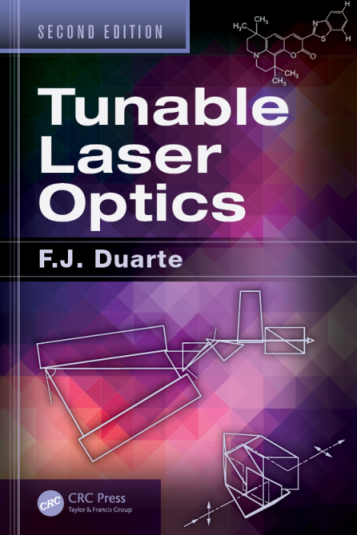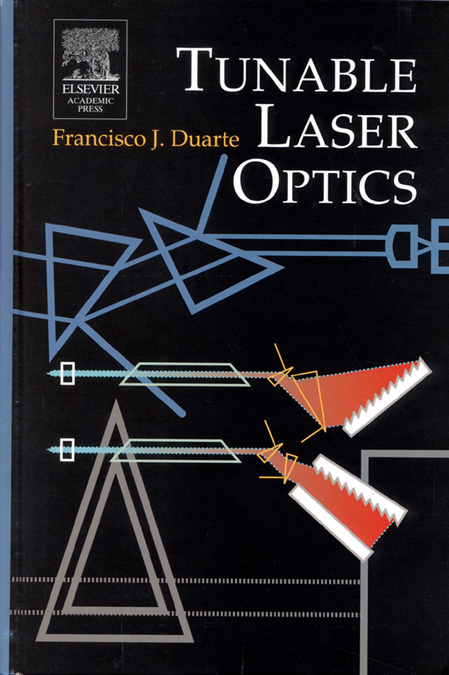

ISBN: 9781482245295
Tunable Laser Optics, 2nd Edition: 171 figures, 44 tables, 746 equations, 72 problems, and 546 archival references in 323 pages.

"Details of interferometric interactions within the tunable laser cavity are precisely described using the Dirac-Feynman approach. Duarte demonstrates a grasp of this powerful quantum mechanics tool that is unparalleled in any other laser text. The chapters applied show such a level of understanding of this material that could be represented by only a handful of scientists in the world. This topic truly is Duarte’s forte’. The transition of the two slit interferometry to the N-slit problem also demonstrates the power of the Dirac-Feynman-Duarte approach.
I want a copy of this book. Nowhere else is there such a clear and concise description of the Dirac-Feynman, and dare I add, Duarte, approach to diffraction and interference theory and applications. This is using quantum mechanics in a very pragmatic and useful way!"
T. S. Taylor, Senior Scientist, US Army Space and Missile Defense Command, USA
"Dr. Duarte is the world’s foremost expert in the area of tunable lasers and has once again written what will become the standard reference for laser researchers. His use of the Dirac Optics notation for compact and concise tracking of the interferometers spectral tuning is not only brilliant physics but also brilliant pedagogically!
Tunable Laser Optics is a definite must have for anyone interested in designing or understanding the physics and engineering of tunable laser systems. It will be a standard for both professionals and students alike! I myself designed a number of tunable laser systems and can tell you that there are no other books that come anywhere close to this presentation."
T. M. Shay, Research Professor, University of New Mexico, USA.
"Tunable Laser Optics is a concise, accessible, and comprehensive review of the field. The book starts from essential physics, and mathematically builds the fundamental equations governing the phenomena related to lasers and laser optics in a clear manner, with outstanding use of figures to illustrate the various points. Incorporation of numerous examples of experimental data alongside the analytical calculations provides an excellent grounding for the reader, and sets the material apart from other texts. In this 2nd edition, updates have been made which incorporate relevant progress in other areas of tunable lasers and laser optics, bridging the gap from first principles to the real- world technological issues. The book should be considered essential reading for theoreticians and experimentalists working in the field today."
K. M. Vaeth, VP Engineering, MicronGen, USA.
"A coherent presentation of the basics of optical resonators for tunable lasers, based on Duarte’s extensive application of the Dirac bra ket procedure to optics. This material is presented concisely, but with sufficient detail so that the reader can clearly understand the application of this approach to tunable laser optics.
The book’s emphasis on the tuning optics provides the common thread connecting the wide range of laser systems discussed and makes it particularly useful to anyone using or constructing tunable laser systems. This second edition of Tunable Laser Optics extends the material presented to be applicable to quantum well, quantum cascade, and quantum dot lasers."
I. S. Falconer, Hon. Senior Lecturer, School of Physics, University of Sydney, Australia.
"I like the examples given in the text… Even a physicist who is not expert in laser optics can replicate the examples, test the theory, and design such good lab experiments for students… The topics presented are well referenced and several results are shown with pictures and numerical data. This book gives a thorough review of laser optics with many worked out examples … These kinds of detailed descriptions of the experiments are not easy to find in a textbook."
E. Gramsch, Professor of Physics, University of Santiago, Chile.
Tunable Laser Optics, 2nd Edition (CRC, New York, 2015) at Amazon
1.1 Introduction
1.1.1 Historical Remarks
1.2 Lasers
1.2.1 Laser Optics
1.2.2 Laser Categories
1.3 Excitation Mechanisms and Rate Equations
1.3.1 Rate Equations
1.3.2 Dynamics of Multiple-Level System
1.3.2.1 Example
1.3.2.2 Example
1.3.3 Transition Probabilities and Cross Sections
1.3.3.1 Example
1.4 The Schrödinger Equation and Semiconductor Lasers
1.4.1 A Heuristic Introduction to the Schrödinger Equation
1.4.2 The Schrödinger Equation via Dirac’s Notation
1.4.3 The Time Independent Schrödinger Equation
1.4.4 Semiconductor Emission
1.4.4.1 Example
1.4.5 Quantum Wells
1.4.5.1 Example
1.4.6 Quantum Cascade Lasers
1.4.7 Quantum Dots
1.5 Introduction to Laser Resonators and Laser Cavities
Problems
2.1 Introduction
2.2 Dirac’s Notation in Optics
2.3 Interference via Dirac’s Notation
2.3.1 Example
2.3.2 Geometry of the N-Slit Interferometer
2.3.3 N-Slit Interferometer Experiment
2.4 Generalized Diffraction
2.4.1 Positive Diffraction
2.5 Positive and Negative Refraction
2.5.1 Example
2.6 Reflection
2.7 Introduction to Angular Dispersion
2.8 Dirac and the Laser
Problems
3.1 Approximate Derivation of the Uncertainty Principle
3.1.1 The Wave Character of Particles
3.1.2 The Diffraction Identity and the Uncertainty Principle
3.1.3 Alternative Versions of the Uncertainty Principle
3.2 Applications of the Uncertainty Principle in Optics
3.2.1 Beam Divergence
3.2.1.1 Example
3.2.2 Beam Divergence and Astronomy
3.2.2.1 Laser Guide Star
3.2.2.1 Example
3.3 The Interferometric Equation and the Uncertainty Principle
3.3.1 Quantum Cryptography
3.3.1.1 Example
Problems
4.1 Introduction
4.2 Generalized Multiple-Prism Dispersion
4.2.1 Double-Pass Generalized Multiple-Prism Dispersion
4.2.1.1 Example
4.2.2 Multiple Return-Pass Generalized Multiple-Prism Dispersion
4.2.2.1 Example
4.2.3 Single-Prism Equations
4.2.3.1 Example
4.3 Multiple-Prism Dispersion and Linewidth Narrowing
4.3.1 The Mechanics of Linewidth Narrowing in Optically Pumped Pulsed Laser Oscillators
4.3.2 Design of a Zero-Dispersion Multiple-Prism Beam Expander
4.3.2.1 Example
4.3.2.2 Example
4.4 Dispersion of Amici, or compound, Prisms
4.4.1 Example
4.5 Multiple-Prism Dispersion and Pulse Compression
4.5.1 Higher Order Phase Derivatives
4.5.1.1 Example
4.6 Applications of Multiple-Prism Arrays
Problems
5.1 Introduction
5.2 Maxwell Equations
5.3 Polarization and Reflection
5.3.1 Plane of Incidence
5.4 Jones Calculus
5.4.1 Example
5.5 Polarizing Prisms
5.5.1 Transmission Efficiency in Multiple-Prism Arrays
5.5.2 Induced Polarization in a Double-Prism Beam Expander
5.6 Double-Refraction Polarizers
5.7 Intensity Control of Laser Beams Using Polarization
5.8 Polarization Rotators
5.8.1 Birefringent Polarization Rotators
5.8.1.1 Example
5.8.2 Broadband Prismatic Polarization Rotators
Problems
6.1 Introduction
6.2 ABCD Propagation Matrices
6.2.1 Properties of ABCD Matrices
6.2.2 Survey of ABCD Matrices
6.2.3 The Astronomical Telescope
6.2.3.1 Example
6.2.4 A Single-Prism in Space
6.2.4.1 Example
6.2.5 Multiple-Prism Beam Expanders
6.2.5.1 Example
6.2.6 Telescope in Series
6.2.7 Single-Return Pass Beam Divergence
6.2.7.1 Example
6.2.8 Multiple-Return Pass Beam Divergence
6.2.8.1 Example
6.2.9 Unstable Resonators
6.2.9.1 Example
6.3 Higher Order Matrices
Problems
7.1 Introduction
7.2 Transverse and Longitudinal Modes
7.2.1 Transverse-Mode Structure
7.2.3 Longitudinal-Mode Emission
7.3 Tunable Laser Oscillator Architectures
7.3.1 Tunable Laser Oscillators without Intracavity Beam Expansion
7.3.2 Tunable Laser Oscillators with Intracavity Beam Expansion
7.3.3 Distributed Feedback Lasers
7.4 Wavelength Tuning Techniques
7.4.1 Prismatic Tuning Techniques
7.4.2 Diffractive Tuning Techniques
7.4.2.1 Example
7.4.3 Synchronous Tuning Techniques
7.4.4 Bragg Gratings
7.4.5 Interferometric Tuning Techniques
7.4.6 Longitudinal Tuning Techniques
7.4.6.1 Example
7.4.7 Birefringent Filters
7.5 Polarization Matching
7.6 Design of Efficient Narrow-Linewidth Tunable Laser Oscillators
7.6.1 Useful Axioms for the design of Narrow-Linewidth Tunable Laser Oscillators
7.7 Narrow-Linewidth Oscillator-Amplifiers
7.7.1 Laser-Pumped Narrow-Linewidth Oscillator Amplifiers
7.7.2 Narrow-Linewidth Master-Oscillator Forced-Oscillators
7.8 Discussion
Problems
8.1 Introduction
8.1.1 Introduction to Nonlinear Polarization
8.2 Generation of Frequency Harmonics
8.2.1 Second Harmonic and Sum Frequency Generation
8.2.2 Difference Frequency Generation and Optical Parametric Oscillation
8.2.3 The Refractive Index in Nonlinear Optics
8.3 Optical Phase Conjugation
8.4 Raman Shifting
8.5 Optical Clockwork
Problems
9.1 Introduction
9.2 Gas Lasers
9.2.1 Pulsed Molecular Gas Lasers
9.2.3 Pulsed Atomic and Ionic Metal Vapor Lasers
9.2.3 Continuous Wave Gas Lasers
9.3. Organic Dye Lasers
9.3.1 Pulsed Organic Dye Lasers
9.3.1.1 Solid-State Tunable Organic Lasers
9.3.2 Continuous Wave Organic Dye Lasers
9.4 Solid-State Lasers
9.4.1 Ionic Solid-State Lasers
9.4.2 Transition Metal Solid-State Lasers
9.4.3 Color Center Lasers
9.4.4 Tunable Diode-Laser Pumped Fiber Lasers
9.4.5 Optical Parametric Oscillators
9.5 Semiconductor Lasers
9.5.1 Tunable Quantum Cascade Lasers
9.5.2 Tunable Quantum Dot Lasers
9.6 Additional Lasers
Problems
10.1 Introduction
10.2 Optical Architecture of the N-slit Laser Interferometer
10.2.1 Beam Propagation in the N-Slit Laser Interferometer
10.2.1.1 Example
10.3 An Interferometric Computer
10.4. Secure Interferometric Communications in Free-Space
10.4.1 Very Large N-Slit Laser Interferometers
10.5 Applications of the N-slit Laser Interferometer
10.5.1 Digital Laser Micromeasurements
10.5.2 Light Modulation Measurements
10.5.3 Wavelength Meter and Temporal Measurements
10.5.4 Imaging Laser Printers
Problems
11.1 Introduction
11.2 Two-Beam Interferometers
11.2.1 The Sagnac Interferometer
11.2.2 The Mach-Zenhder Interferometer
11.2.3 The Michelson Interferometer
11.3 Multiple-Beam Interferometers
11.3.1 The Hambury Brown - Twist Interferometer
11.3.2 The Frabry-Perot Interferometer
11.3.3 Design of Frabry-Perot Etalons
11.4 Coherent and Semicoherent Interferograms
11.5 Interferometric Wavelength Meters
11.5.1 Frabry-Perot Wavelength Meters
Problems
12.1 Introduction
12.2 Spectrometry
12.2.1 Prism Spectrometers
12.2.2 Diffraction Grating Spectrometers
12.2.2.2.1 Example
12.3 Dispersive Wavelength Meters
Problems
13.1 Fundamental Physical Constants
13.2 Conversion Quantities
13.3 Units of Optical Quantities
13.4 Dispersion Constants of Optical Materials
13.5 Refractive Index and dn/dT of Laser and Optical Materials
Problems
ISBN: 0-12-222696-8
Tunable Laser Optics includes 134 figures, 34 tables, 547 equations, 52 problems, and 435 archival references in 272 pages. Detailed solutions to the problems will be made available, in PDF form, to professors and faculty using Tunable Laser Optics as a textbook. Please e-mail if you are interested.
A list of corrections, for the readers of Tunable Laser Optics, is available in PDF form.

(2005).jpg)
"Tunable Laser Optics is a well-organized and well-written book that was conceived for very practical purposes. It serves as a handbook but is actually much more than that... The author first establishes a good mix of the physical theory and then discusses the details and design considerations for tunable laser optics systems. The reader gains great insight and understanding into... tunable laser optics. I enjoyed the book and commend F. J. Duarte on another addition to his already impressive resume in optical science."
D. Finsmith, Optics & Photonics News 16 (7), 62 (2005).
"The use of Dirac's notation for the calculation of the interference and diffraction effects of the tuning elements proves an elegant and powerful technique for designing tunable laser systems. The complete coverage of the technical area and the easy readable writing style of the author will ensure that Tunable Laser Optics will be a classic reference that will be enjoyed by both students and researchers. I give Tunable Laser Optics my strongest recommendation."
T. M. Shay, in Amazon.com (December, 2003)
"The Dirac notation and the Heisenberg uncertainty principle are used to explain properties of light. This gives a solid mathematical and physical background to solve the optics problems arising in the design and construction of tunable laser optical systems... Tunable Laser Optics introduces the warfare that a student, or an experimentalist, needs to understand for the successful design and construction of tunable lasers and optical devices."
I. Olivares, in Amazon.com (November, 2003)





.jpg)




Page published on the 1st of September, 2003
Updated on the 20th of June, 2023